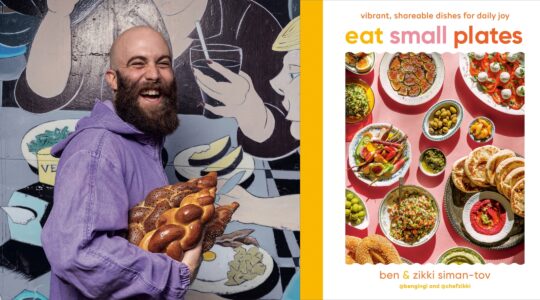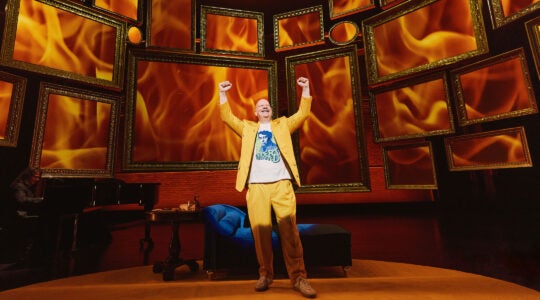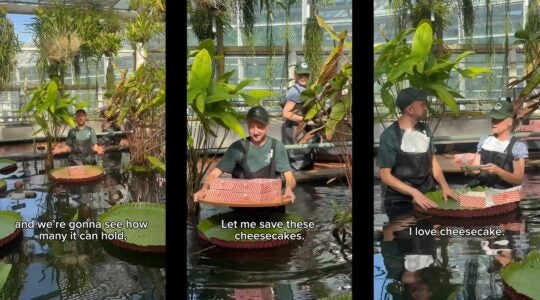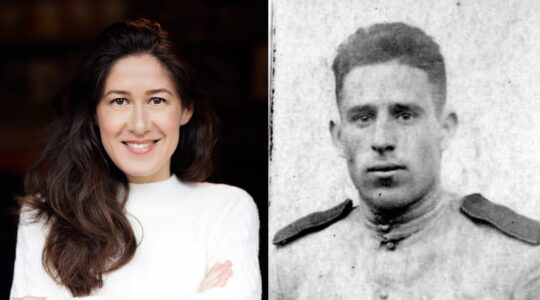What is it about “Fiddler on the Roof” that has such a hold on us, half a century on?
The adaptation of Sholem Aleichem’s stories about Tevye and his family for the Great White Way not only broke all Broadway records in 1964, but created a frame of reference for American Jews to discuss who they were, where they were going, and what Judaism meant. Attending the play, watching the movie, putting on school productions or singing the songs at home became part of an elaborate communal ritual for over half a century.
Offering another bold metaphor, one might suggest that just as the Musaf service stands in for (and has transformed) the lost Temple sacrifice, “Fiddler” represents the values (and has interpreted for us) the Eastern European Jewish past.
Most American Jews, I dare say, would not want to reconstitute the ancient Jewish sacrifices, just as most would not want to return to a pogrom-fueled Pale of Settlement. And yet … we return over and over to the world of Anatevka, memorizing the trope of “Sunrise, Sunset,” recalling the rhetorical power of “…on the other hand…” and wondering, each and every time, if the storybook wedding of Tzeitel and Motl will really, truly, end in violence.
Alisa Solomon, the keynote speaker at the recent “Fiddler at Fifty” symposium held at Stanford University and Berkeley’s Graduate Theological Union — one of many events around the country celebrating 50 years since the opening of the Broadway extravaganza — has just published “Wonder of Wonders: A Cultural History of Fiddler on the Roof” (Metropolitan Books). A compulsively readable history of the play, its origins and its legacy, this Talmudic gloss on “Fiddler” reveals the many contradictions, iterations and revisions surrounding Aleichem’s beloved story.
The history she retells is partly about “Fiddler” as an ongoing interpretation of Sholem Aleichem’s Tevye tales, which guides our understanding of the modern Jewish condition. But it is just as much the story of a unique, groundbreaking work of theater, and the way great art speaks to people across generations, cultures and languages. Among other things, we learn that in 1971 there were 15 productions of the play in Finland; that a famous Japanese producer wondered how Americans created a play that was “so Japanese”; that the Temptations Motowned the lyrics of “Matchmaker, Matchmaker” to read “…I wouldn’t holler if she was the grooviest girl in town.”
But it is the story of the transformation of “Fiddler” from story to play to movie to ritual that most interests me. What are we to make of Solomon’s observation that some kids at summer camp “sing ‘Sabbath Prayer’ on Friday evening as they light candles in place of the Hebrew blessing?” Or that even Chabad, during its razzle-dazzle telethon, references “Fiddler” when it’s time to double down on the authenticity of its fundraising?
Solomon reminds us of the power of the stage to enact larger social dramas. In a fascinating chapter on a recent production of “Fiddler” in Poland, she explains how an open-air staging in the town of Dynow broke down “the traditional barrier between an actor and spectator.” The 20something non-Jewish director, Magdalena Miklasz, “wanted to present “Fiddler” as a way of recalling Dynow’s multicultural past — and as a way of looking toward Poland’s European future.” Many Jews have seen “Fiddler,” the stand-in for a lost Jewish European identity, as part of a “Jewish search for a usable past,” as scholar David Roskies put it. And now, “wonder of wonder, miracle of miracles,” it is being used to invoke the Polish search for a usable future.
The framing of “Fiddler” as large-scale communal theater reminds one of the power of the Passion Plays, medieval Christian dramas in which the death of Jesus is enacted with communal participation (often with bad repercussions for Jews), or the power of the original Greek tragedies, which were more communal rituals than strict performances.
But let us not delve too deeply into the ancient and the lachrymose. For the power of ritual in Jewish life is not just to commemorate and interpret the past, but also to celebrate the present. And so it was entirely appropriate that a freylach (or joyous) feeling permeated “Fiddler at 50,” during which Stanford Professor Gabriella Safran broke the fourth wall and asked the audience to sing a few bars — everyone in tune, everyone knowing all the words.
Tevye tells us that the Jewish position in the world is “as shaky as a fiddler on the roof.” More than 50 years into an unprecedented era of Jewish confidence in America, Solomon offered another view, of a play — and by extension a people — whose place in American now feels “as stable as a fiddler on the roof.”
Daniel Schifrin has just finished his term as writer-in-residence at the Contemporary Jewish Museum in San Francisco.
The New York Jewish Week brings you the stories behind the headlines, keeping you connected to Jewish life in New York. Help sustain the reporting you trust by donating today.




